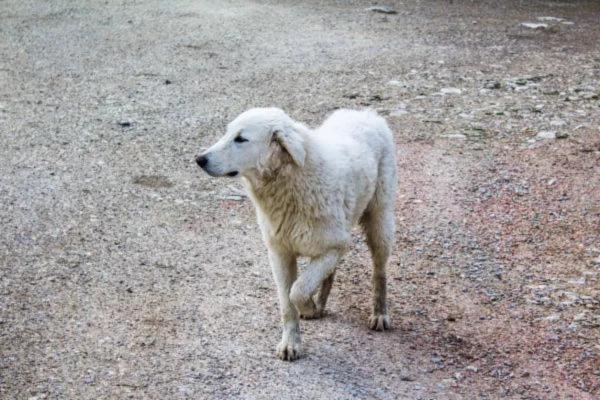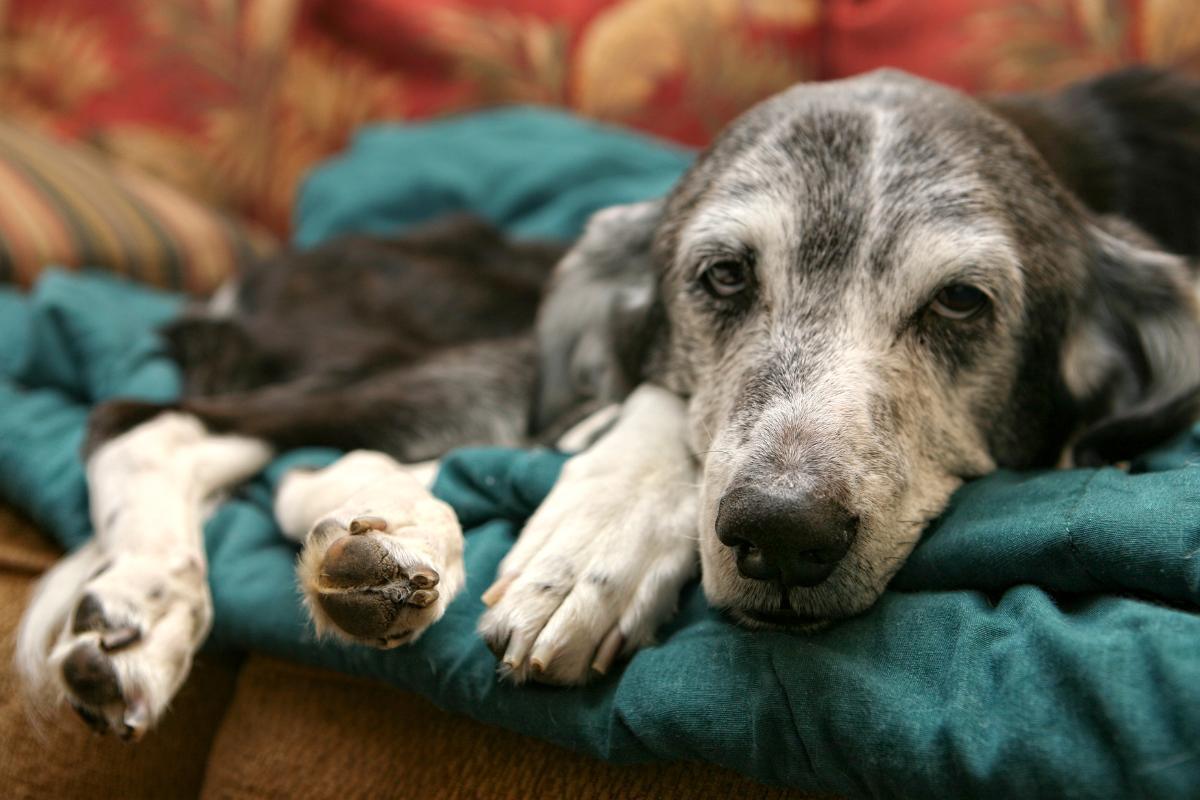My Dog Is Shivering But It's Not Cold



See files for Dogs
Despite having a coat of hair, dogs will shiver when it is sufficiently cold. It is for this reason we often provide additional artificial coats when the temperatures drop. This does not explain why my dog is shivering, but it's not cold. In these cases, tremors and shakes can be due to various factors. They can be pathological, environmental or even psychological. AnimalWised looks at the main reasons for shaking in dogs and explains what action must be taken in each case to best ensure their health and wellbeing.
Hypothermia
Although this is a reason why a dog is shivering when it's not cold, it usually occurs when they have recently been exposed to very low temperatures. However, there are also other reasons why a dog might experience hypothermia. Essentially, hypothermia is the body's response when it loses a greater amount of heat than it can produce on its own. This can either be due to excessive heat loss or when there is a decrease in heat production.
Generally speaking, hypothermia can be caused by one of the following situations:
- Very cold environmental temperatures: it is especially frequent in puppies as they have less capacity for thermoregulation. If you are wondering why my puppy is shivering, we need to ensure they are being suitably protected from low-temperature environments.
- Pathological causes: such as hypothyroidism, terminal stages of disease, shock, sepsis and central nervous system lesions that affect the temperature regulating center.
Regardless of the cause, when there is a drop in body temperature, the body responds by increasing endogenous heat production (i.e. the amount of heat it can produce). One way of generating heat results in the body having tremors as these increase muscle activity and warm up tissues.
To reverse hypothermia it is essential to identify its underlying cause. If a pathological cause is responsible, it will be necessary to establish a specific treatment against it. If the cause is the low environmental temperature, it will be necessary to provide heat and avoid the loss of more temperature. We need to do this in a way which doesn't cause the dog to go into shock, meaning we cannot heat them too rapidly:
- Place near a heat source: you can place a heat seed pack attached to the trunk of the animal or apply hot air with a blow dryer. You can also heat a dry cloth in the microwave and cover your dog with it. It is not recommended to use electric blankets, since they often generate burns on the skin of dogs.
- Provide a hot broth: when the temperature has risen slightly, you can offer your dog a chicken or meat broth (without salt) to help him recover their temperature.
You can learn more about what to do in this situation with our guide to the causes, symptoms and treatment of hypothermia in dogs.
Fever
Although your dog may be shivering when their body temperature is low, the same symptom can occur when their body temperature is high. Fever is the term we use for a body temperature which is higher that the normal range. It differs from hyperthermia in that the latter is due to a thermoregulation failure, not as a response to a pathological state as is the case with fever.
Medically known as pyrexia, fever in dogs is not a disease, but a symptom of various pathological causes. When a dog suffers from a condition which causes fever, the hypothalamic regulatory center readjusts to a higher temperature. This occurs due to the action of molecules called pyrogenetic cytokines. When the hypothalamic center readjusts, the body sets in motion mechanisms to produce endogenous heat and increase that temperature.
It is this readjustment by the hypothalamus which results in the dog shaking. This occurs during the first febrile phase, known as the rising phase. When a dog is shivering due to fever and not cold, it is important to identify the primary cause. Only then can you establish a specific therapy to treat it. You can also carry out the following to help reduce their body temperature:
- Administer antipyretic drugs: usually Non-Steroidal Anti-Inflammatory Drugs (NSAIDs). Medications for human use such as ibuprofen or paracetamol should never be administered since they are highly toxic to the canine species.
- Use wet cloths or compresses: place them in areas with little hair such as the groin, armpits, abdomen and ears. The cloths should never be moistened with excessively cold water, since the objective is to reduce the temperature gradually.
To understand why a dog is shivering when it's not cold, we need to look at the context of this behavior. You can learn more about one such context with our article on why a dog is shaking and acting weird.

Pain
The following reason why a dog shaking when it isn't cold is not related to body temperature. One of the most common reasons a dog is taken to the veterinarian is due to shaking. If they have had a traumatic incident when we are not around, it can seem like the dog is shivering all of a sudden for no reason. This can occur because there are no lesions on the outside, but they may have internal tissue damage.
Dogs are good at hiding their pain. However, once sufficiently intense, their body will betray them and the dog will manifest various symptoms of pain. Once such symptom is their body shaking. It might be the shivering and trembling is restricted to the localized area where they have an injury, but it is also possible they will have generalized shaking.
Some of the common reasons a dog shakes due to pain include:
- Orthopedic problems: such as arthritis and osteoarthritis in dogs.
- Blunt force trauma: if the dog has fallen from height, been involved in a collision or had any other form of physical trauma, it can result in severe pain.
- Abdominal issues: since the abdomen contains some of the dog's vital organs, internal problems can result in acute abdominal pain. It occurs in cases of intestinal obstructions, pancreatitis, pyometra in dogs and many others.
To reverse these clinical signs, it is essential to identify the cause and provide appropriate treatment. Pain management will likely be included in this treatment. The most common form of pain management will be in the form of analgesics such as NSAIDs which can also treat accompanying inflammation and may reduce fever. Learn more about one type of NSAID for canine use with our article on carprofen for dogs.
Anemia
So far, the reasons a dog is shaking when it's not cold have been due to acute issues, but chronic problems can result in trembling symptoms. Anemia can be acute or chronic, depending on the cause. In a basic sense, anemia is a decrease in the number of red blood cells present in the dog's blood.
The deficiency of red blood cells leads to a lower oxygen supply to the body's tissues. This gives rise to a clinical picture characterized by signs such as pale mucous membranes, intolerance to exercise, weakness, tachycardia and tachypnea. In addition, it is common for other symptoms to appear, including tremors. It is important to include anemia as another possible differential diagnosis that can cause tremors in dogs.
According to its origin, anemia in dogs can be classified into three large groups:
- Hemorrhagic anemia: due to blood loss.
- Hemolytic anemia: due to destruction of red blood cells.
- Hypoproliferative anemia: due to decreased production of red blood cells.
The causes that can generate a picture of anemia in dogs are varied. They can include infectious diseases, parasitic infestation, poisoning, immune-mediated diseases, tumors and others. Identifying its origin will be essential to propose an adequate and specific therapeutic protocol that allows reversing anemia. Learn more with our guide to hemolytic anemia in dogs.
Hypoglycemia
Hypoglycemia is another of the possible causes that can cause your dog to tremble as if it were cold. Hypoglycemia is defined as decreased blood glucose levels. Such a decrease can appear as a consequence of poor insulin management in diabetic dogs, excessive exercise, diseases such as canine Addison's disease or tumors such as insulinoma in dogs.
In general, hypoglycemia presents an emergency situation that requires quick action. In the event of hypoglycemia, a high-sugar product such as jam or honey should be applied to the animal's gums. Although these foodstuffs should not be part of a dog's general diet, they can help in emergency situations to increase the dog's blood-sugar levels quickly.
We will need to know the cause of their hypoglycemia. We will need to take them to the veterinarian to determine the cause and treat it specifically. If the dog has already been diagnosed with a health issue such as diabetes mellitus in dogs, we may be able to manage it ourselves. However, if a diabetic dog has regular hypoglycemic episodes, we need to take them to a veterinarian for reassessment.
Psychological or emotional causes
If you see that your dog trembles as if it were cold, it may also be due to psychological or emotional issues. These may include:
- Traumas: generally due to abandonment or mistreatment in previous stages of life.
- Phobias: loud noises, vehicles, people, etc.
- Anxiety: such as separation anxiety in dogs.
- Stressful situations: a typical example is visits to the vet.
If you think the appearance of tremors in your dog is due to a psychological or emotional reaction, it is best to consult a canine behavior specialist. They will help identify the cause of the problem and guide you on possible solutions.
Cerebellar diseases
The cerebellum has two primary functions, coordinating movements and maintaining balance. When a lesion of the cerebellum occurs, these functions are altered and a set of clinical signs appears known as cerebellar syndrome. One of the classic symptoms of cerebellar syndrome is intention tremor .
When the animal makes a voluntary movement, the decision is made by the brain, but it is the cerebellum that is in charge of redirecting the action. When the cerebellum is affected, it does not correct the actions. The movement becomes fractionated, providing the characteristic tremor of cerebellar pathologies. The tremor is said to be intentional because it occurs during voluntary movement, while it disappears at rest.
Cerebellar syndrome is not a disease in itself, but a set of symptoms that may appear associated with various cerebellar diseases. The most important cerebellar diseases in dogs are:
- Congenital malformations: such as cerebellar hypoplasia or Chiari malformation.
- Degenerative diseases: such as cerebellar abiotrophy.
- Cerebellar tumors: tumors which develop on the cerebellum itself.
- Cerebellar infarcts: a stroke located in the cerebellum.
- Inflammatory processes: such as idiopathic cerebellitis (also called shaker syndrome in dogs).
As you can imagine, the treatment and prognosis will be different for each diseases. When symptoms compatible with this syndrome appear, it will be essential to make an accurate diagnosis in order to establish the most appropriate treatment in each case.

Puerperal eclampsia
If your dog has just given birth and is shaking when it's not cold, it is likely they are suffering puerperal eclampsia. Eclampsia is an acute picture of hypocalcemia in dogs that occurs at the time of delivery or in the immediate postpartum period
Puerperal eclampsia is characterized by the appearance of very striking tonic-clinical contractions throughout the body. First-time mothers and small breeds are the most affected, although the picture can appear in bitches of any breed. It is especially common in those with larger litters.
This is a medical emergency that requires immediate treatment with intravenous calcium gluconate. If treated quickly, the condition resolves in a few hours. If action is not taken promptly, the outcome can be fatal.

This article is purely informative. AnimalWised does not have the authority to prescribe any veterinary treatment or create a diagnosis. We invite you to take your pet to the veterinarian if they are suffering from any condition or pain.
If you want to read similar articles to My Dog Is Shivering But It's Not Cold, we recommend you visit our Other health problems category.







